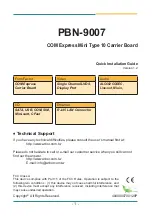
TPCE260 User Manual Issue 1.0.3
Page 11 of 17
5 PMC Interface
PMC BUSMODE[4:1] Signals
The BUSMODE[4:1]# signals are defined in the IEEE1386 (CMC) specification and allow a host to identify the
used mezzanine card type. The TPCE260 supports PMC cards only.
The TPCE260 indicates the “PMC only” support with the signal levels presented in the table below. The PMC
card should decode these signals and drive out a logic “0” on BUSMODE1#.
Signal
Logic Level
BUSMODE4#
Pulled LOW
BUSMODE3#
Pulled LOW
BUSMODE2#
Pulled HIGH
Table 5-1 : TPCE260 PMC BUSMODE[4:1] Signals
PCI Signaling Voltage
PMC modules are specified either for 3.3V only, 5V only or universal (3.3V or 5V) PCI signaling voltage
operation.
The TPCE260 onboard V_I/O voltage level defines the PCI signaling voltage level for the TPCE260 PCI bus.
A voltage keying pin indicates the voltage level and prevents incompatible PMC modules from being plugged
onto the carrier.
TPCE260
V_I/O Configuration
5V Keying Pin
3.3V Keying Pin
-x0
5V
Installed
Not Installed
-x1
3.3V
Not Installed
Installed
Table 5-2 : TPCE260 PCI Signaling Voltage Factory Defaults
5.2.1 V_I/O Configuration
The V_I/O signaling voltage level is configured by three resistors. To change the voltage level, these resistors
must be soldered to the appropriate soldering terminals. They are grouped and labeled appropriately.
Figure 5-1 : PCI Signaling Voltage
Configuration Resistors
TPCE260 V_I/O
Populated
Resistors
Unpopulated
Resistors
5V
R500,
R501,
R502
R300,
R301,
R302
3.3V
R300,
R301,
R302
R500,
R501,
R502
Table 5-3 : PCI Signaling Voltage Configuration Resistors


































